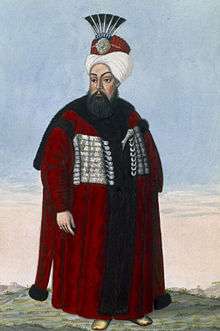Ahmed II
| Ahmed II احمد ثانى | |||||
|---|---|---|---|---|---|
|
Sultan of the Ottoman Empire Kayser-i Rûm Custodian of the Two Holy Mosques Caliph of Islam | |||||
 | |||||
| 21st Ottoman Sultan (Emperor) | |||||
| Reign | 22 June 1691 – 6 February 1695 | ||||
| Predecessor | Suleiman II | ||||
| Successor | Mustafa II | ||||
| Born |
25 February 1643 Istanbul, Ottoman Empire | ||||
| Died |
6 February 1695 (aged 51) Edirne, Ottoman Empire | ||||
| Consort |
Rabia Sultan Şayeste Kadın | ||||
| Issue | see below | ||||
| |||||
| Dynasty | Ottoman | ||||
| Father | Ibrahim | ||||
| Mother | Muazzez Sultan | ||||
| Religion | Sunni Islam | ||||
| Tughra |
| ||||
Ahmed II (Ottoman Turkish: احمد ثانى Aḥmed-i sānī) (25 February 1643 – 6 February 1695) was the Sultan of the Ottoman Empire from 1691 to 1695. Ahmed II was born at Topkapı Palace, Constantinople, the son of Sultan Ibrahim (1640–48) by Muazzez Sultan, and succeeded his brother Suleiman II (1687–91) in 1691.
Early life
Ahmed II was born on 25 February 1643, the son of Sultan Ibrahim and Muazzez Sultan. During the reigns of his older brothers, Ahmed was imprisoned in Kafes, and he stayed there almost 43 years.
Reign
During his short reign, Sultan Ahmed II devoted most of his attention to the wars against the Habsburgs and related foreign policy, governmental and economic issues. Of these, the most important were the tax reforms and the introduction of the lifelong tax farm system (malikane) (see tax farming). Following the recovery of Belgrade under his predecessor, Suleiman II, the military frontier reached a rough stalemate on the Danube, with the Habsburgs no longer able to advance south of it, and the Ottomans attempting, ultimately unsuccessfully, to regain the initiative north of it.
Among the most important features of Ahmed's reign was his reliance on Köprülüzade Fazıl Mustafa Pasha. Following his accession to the throne, Sultan Ahmed II confirmed Köprülüzade Fazıl Mustafa Pasha in his office as grand vizier. In office from 1689, Fazıl Mustafa Pasha was from the famous Köprülü family of grand viziers, and like most of his Köprülü predecessors in the same office, was an able administrator and military commander. Like his father Köprülü Mehmed Pasha (grand vizier 1656–61) before him, he ordered the removal and execution of dozens of corrupt state officials of the previous regime and replaced them with men loyal to himself. He overhauled the tax system by adjusting it to the capabilities of the taxpayers affected by the latest wars. He also reformed troop mobilization and increased the pool of conscripts available for the army by drafting tribesmen in the Balkans and Anatolia. In October 1690 he recaptured Belgrade (northern Serbia), a key fortress that commanded the confluence of the rivers Danube and Sava; in Ottoman hands since 1521, the fortress had been conquered by the Habsburgs in 1688.
Fazıl Mustafa Pasha's victory at Belgrade was a major military achievement that gave the Ottomans hope that the military debacles of the 1680s—which had led to the loss of Hungary and Transylvania, an Ottoman vassal principality ruled by pro-Istanbul Hungarian princes— could be reversed. However, the Ottoman success proved ephemeral. On 19 August 1691, Fazıl Mustafa Pasha suffered a devastating defeat at the Battle of Slankamen (northwest of Belgrade) at the hands of Ludwig Wilhelm von Baden, the Habsburg commander in chief in Hungary, fittingly nicknamed “Türkenlouis” (Louis the Turk) for his victories against the Ottomans. In the confrontation, recognized by contemporaries as “the bloodiest battle of the century,” the Ottomans suffered heavy losses: 20,000 men, including the grand vizier. With him, the sultan lost his most capable military commander and the last member of the Köprülü family, who for the previous half century had been instrumental in strengthening the Ottoman military.
Under Fazıl Mustafa Pasha's successors, the Ottomans suffered further defeats. In June 1692 the Habsburgs conquered Várad (Oradea, Romania), the seat of an Ottoman governor (beylerbeyi) since 1660. In 1694 they attempted to recapture Várad, but to no avail. On 12 January 1695, they surrendered the fortress of Gyula, the center of an Ottoman sanjak or subprovince since 1566. With the fall of Gyula, the only territory still in Ottoman hands in Hungary was to the east of the River Tisza and to the south of the river Maros, with its center at Temesvár. Three weeks later, on 6 February 1695, Ahmed II died in Edirne Palace.
Family
- Consorts
- Rabia Sultan;[1]
- Şayeste Kadın.[2]
- Sons
- Şehzade Ibrahim (Edirne Palace, Edirne, 6 October 1692 – Topkapı Palace, Istanbul, 4 May 1714, buried in Turhan Hatice Sultan Mausoleum, New Mosque), with Rabia Sultan, twin with Selim, became Crown Prince on 22 August 1703;
- Şehzade Selim (Edirne Palace, Edirne, 6 October 1692 – Edirne Palace, Edirne, 15 May 1693), with Rabia Sultan, twin with Ibrahim.
- Daughters
- Asiye Sultan[3] (Edirne Palace, Edirne, 24 December 1693 – Eski Palace, Bayezid, Istanbul, 9 December 1695, buried in Suleiman I Mausoleum, Süleymaniye Mosque), with Rabia;
- Atike Sultan[3] (born and died 21 October 1694).
Further reading
- Finkel, Caroline (2005). Osman's Dream: The Story of the Ottoman Empire, 1300-1923. New York: Basic Books. ISBN 978-0-465-02396-7.
- Michael Hochendlinger, Austria's Wars of Emergence: War, State and Society in the Habsburg Monarchy, 1683–1797 (London: Longman, 2003), 157–64.
References
External links
![]()
![]()
Ahmed II Born: 25 February 1643 Died: 6 February 1695 | ||
| Regnal titles | ||
|---|---|---|
| Preceded by Suleiman II |
Sultan of the Ottoman Empire 22 June 1691 – 6 February 1695 |
Succeeded by Mustafa II |
| Sunni Islam titles | ||
| Preceded by Suleiman II |
Caliph of Islam Ottoman Caliph 22 June 1691 – 6 February 1695 |
Succeeded by Mustafa II |
